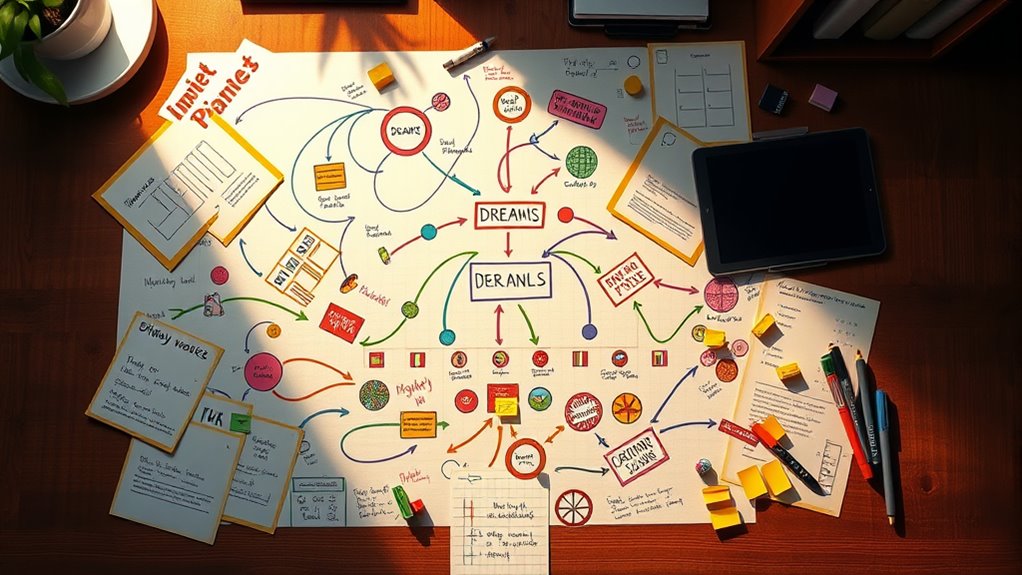When you miss a day in your streak, it can disrupt the mental and neurological momentum you’ve built, making the habit feel less automatic and more effortful. Streaks boost your confidence through dopamine, reinforcing your behavior and shaping your identity. Losing a streak can trigger feelings of failure or loss aversion, causing emotional setbacks. Understanding how these psychological and brain responses work helps you grasp why that one missed day matters—and how to manage it effectively.
Key Takeaways
- Missing a day breaks the neural reinforcement, weakening the mental association and making it harder to resume the habit.
- A lost streak reduces dopamine levels, diminishing motivation and increasing the risk of abandoning the activity.
- The psychological impact of missing a day can trigger feelings of failure, guilt, and a desire to overcompensate.
- Streaks create a positive feedback loop; interruption can cause a setback in confidence and momentum.
- Recognizing the importance of consistency helps develop resilient habits and prevents the detrimental effects of streak disruptions.

Have you ever wondered why streaks—whether in sports, gambling, or personal habits—seem to build momentum and feel unstoppable? The answer lies in how streaks influence your habit formation and trigger psychological effects that keep you hooked. When you start a new habit, consistency is key. Every time you perform the activity, your brain reinforces the behavior, creating a mental association that makes repeating it easier. As these repetitions accumulate into a streak, your brain begins to see the behavior as part of your identity. This mental shift fuels your motivation, making it feel almost automatic to keep going. The psychological effects of maintaining a streak boost your confidence and sense of achievement, reinforcing the cycle. It’s a powerful loop: success breeds success, and streaks become a tangible measure of progress.
But it’s not just about feeling good. When you’re on a streak, your brain experiences a release of dopamine, the chemical linked to reward and motivation. This surge makes you feel good, encouraging you to continue the streak. It’s a positive feedback loop that makes missing even a single day feel like a setback, threatening the progress you’ve built. The fear of losing your streak can be just as motivating as the initial desire to start a habit, which is why many people become obsessed with maintaining their streaks. This attachment to the streak can sometimes override rational judgment, leading you to push through when you’re not feeling well or when it’s genuinely unnecessary. Additionally, understanding the role of heat pump technology in energy efficiency can help you make informed decisions about sustainable living and reduce your carbon footprint. Missing just one day can trigger a psychological effect called “loss aversion,” where the pain of losing a streak outweighs the pleasure of continuing it. This often compels you to double down, trying to restore the streak as quickly as possible. However, it can also cause anxiety or guilt if you slip up, which might derail your overall progress. The key is understanding that streaks are more than just numbers—they’re a reflection of your commitment and the mental associations you’ve built. Recognizing the psychological effects at play helps you approach streaks with a healthier mindset, avoiding the trap of all-or-nothing thinking. Ultimately, the power of streaks lies in how they shape your habits and influence your psychological state, making each day’s effort essential to long-term success.
Frequently Asked Questions
How Do Streaks Impact Long-Term Motivation?
Streaks can boost your long-term motivation by reinforcing habit formation through motivation psychology. When you maintain a consistent streak, you build momentum, making it easier to stay committed. Missing a day might interrupt this momentum, leading to decreased motivation and potential habit breakdown. Staying aware of streaks helps you stay focused, encouraging persistence and reinforcing positive behaviors, which ultimately strengthens your long-term commitment to your goals.
Can Missing a Day Actually Strengthen Your Streak?
Imagine your habit as a steel chain; missing a day might seem like a weak link, but it can actually make your chain stronger. Sometimes, missing a day during habit formation builds psychological resilience, teaching you to bounce back and stay committed. Instead of breaking your streak, it can reinforce your motivation, showing you that setbacks don’t defeat your progress—they strengthen your resolve to keep going.
Does the Type of Activity Affect Streak Persistence?
You might wonder if the activity type influences your streak persistence. Different activities impact habit formation differently; for example, physical exercise can be more resilient to variability than reading. Activity variability plays a role; consistent routines help build stronger habits, making streaks more durable. So, when choosing activities, consider how steady you can stay with them—more consistent ones tend to support longer, more resilient streaks.
Are There Optimal Streak Lengths for Different Goals?
Think of it as finding the sweet spot in habit formation—you don’t want your streak to be too short or too long. Ideal streak lengths vary based on your goals, making goal setting more effective. For some habits, a 21-day streak cements the routine, while others benefit from longer or shorter periods. Tailor your streaks to what motivates you, and remember, consistency beats intensity.
How Does Individual Personality Influence Streak Maintenance?
Your personality traits play a big role in how you maintain streaks. If you’re naturally disciplined, habit formation becomes easier, helping you stay consistent. On the other hand, if you’re more impulsive or easily distracted, you might struggle with streaks. Recognizing your personality traits allows you to tailor your approach, creating habits that fit your style. This personalized strategy can make streak maintenance more achievable and sustainable over time.
Conclusion
So, next time you miss a day, remember it’s not the end of your streak. Imagine a runner who’s kept up daily workouts for months—missing just one day might seem small, but it could break their momentum. Staying consistent keeps progress steady and habits strong. Don’t let one missed day discourage you; instead, see it as a chance to get back on track and keep building your streak toward success.








